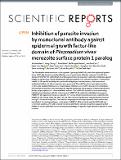Inhibition of parasite invasion by monoclonal antibody against epidermal growth factor-like domain of Plasmodium vivax merozoite surface protein 1 paralog
Abstract
The Plasmodium vivax merozoite surface protein 1 paralog (PvMSP1P), which has epidermal growth factor (EGF)-like domains, was identified as a novel erythrocyte adhesive molecule. This EGF-like domain (PvMSP1P-19) elicited high level of acquired immune response in patients. Antibodies against PvMSP1P significantly reduced erythrocyte adhesion activity to its unknown receptor. To determine PvMSP1P-19-specific antibody function and B-cell epitopes in vivax patients, five monoclonal antibodies (mAbs) and 18-mer peptides were generated. The mAb functions were determined by erythrocyte-binding inhibition assay and invasion inhibition assay with P. knowlesi. B-cell epitopes of PvMSP1P-19 domains were evaluated by peptide microarray. The pvmsp1p-19 sequences showed limited polymorphism in P. vivax worldwide isolates. The 1BH9-A10 showed erythrocyte binding inhibitory by interaction with the N-terminus of PvMSP1P-19, while this mAb failed to recognize PkMSP1P-19 suggesting the species-specific for P. vivax. Other mAbs showed cross-reactivity with PkMSP1P-19. Among them, the 2AF4-A2 and 2AF4-A6 mAb significantly reduced parasite invasion through C-terminal recognition. The linear B-cell epitope in naturally exposed P. vivax patient was identified at three linear epitopes. In this study, PvMSP1P-19 N-terminal-specific 1BH9-A10 and C-terminal-specific 2AF4 mAbs showed functional activity for epitope recognition suggesting that PvMSP1P may be useful for vaccine development strategy for specific single epitope to prevent P. vivax invasion.
Citation
Han , J-H , Cheng , Y , Muh , F , Ahmed , M A , Cho , J-S , Nyunt , M H , Jeon , H-Y , Ha , K-S , Na , S , Park , W S , Hong , S-H , Shin , H-J , Russell , B & Han , E-T 2019 , ' Inhibition of parasite invasion by monoclonal antibody against epidermal growth factor-like domain of Plasmodium vivax merozoite surface protein 1 paralog ' , Scientific Reports , vol. 9 , 3906 . https://doi.org/10.1038/s41598-019-40321-2
Publication
Scientific Reports
Status
Peer reviewed
ISSN
2045-2322Type
Journal article
Collections
Items in the St Andrews Research Repository are protected by copyright, with all rights reserved, unless otherwise indicated.

